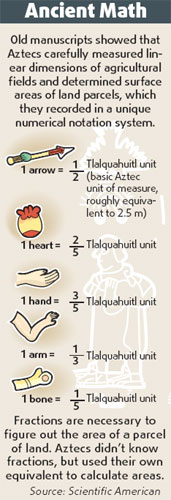Aztecs devised arithmetic system
(Agencies)
Updated: 2008-04-05 10:03
Updated: 2008-04-05 10:03
WASHINGTON: Using written symbols such as hearts, arrows and hands, the ancient Aztecs maintained an arithmetic system that was far more complex than previously understood, scientists said on Thursday.
The Aztecs, an empire in central Mexico toppled by Spanish invaders in 1519, has long been recognized for its sophistication in architecture, engineering, astronomy and other fields. And the new research confirms arithmetic can be added to the list.

The researchers examined hundreds of drawings in two manuscripts dating back to between 1540 and 1544 that were used to document agricultural properties by the Aztec people in the city-state of Tepetlaoztoc, near modern-day Mexico City.
The Aztecs used a system that included symbols of hearts, hands, arrows, bones and arms as alternatives to using fractions. An examination of these hieroglyphic records showed the Aztecs used their own calculation system to figure out, for example, the area of a parcel of land.
Barbara Williams, a researcher at the University of Wisconsin-Rock County, said: "What we thought we knew about the Aztec measuring system was a little simplistic. We've determined that it was more complex."
Williams worked with Maria del Carmen Jorge y Jorge of the Universidad Nacional Autonoma de Mexico on the study, which was published in the journal Science.
"They used the four mathematical operations of addition, subtraction, multiplication and division. But in almost all of the early societies, they could do everything they needed to do, with just those four. They didn't need square roots. They didn't need trigonometry," Williams said.
The two manuscripts - one found in a library in France and the other in Mexico - were written on European paper by Aztecs a couple of decades after the conquest, using the Aztec system.
They were land records drawn up that helped determine taxation imposed on the local people by the Spaniards, Williams said.
The fact the Aztecs mathematically calculated areas has been known since 1980, but until now there was little understanding of how they did it, Williams said.
The Aztec empire held sway over a large part of Mesoamerica for about a century until the arrival of the Spanish, and their capital Tenochtitlan - with towering pyramids and sumptuous architecture - was larger than any European city of the era.
|
||
|
||
|
|
|
|